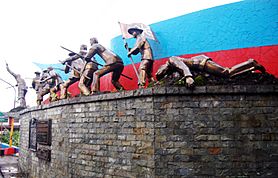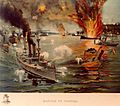Philippine Revolution facts for kids
Quick facts for kids Philippine RevolutionHimagsikang Pilipino |
|||||||
|---|---|---|---|---|---|---|---|
|
|
|||||||
|
|||||||
| Belligerents | |||||||
|
1896–1897
|
1896–1897 |
||||||
|
1898
|
1898 |
||||||
| Commanders and leaders | |||||||
|
Supremo: |
Queen Regent: Governor-Generals: (1896) (1896–1897) (1897–1898) (1898) (1898) (1898) Other leaders: |
||||||
| Strength | |||||||
| 40,000–60,000 (1896) Filipino Revolutionaries | 12,700–17,700 before the Revolution, around 55,000 (30,000 Spanish; 25,000 Filipino Loyalists) by 1898 | ||||||
| Casualties and losses | |||||||
| Heavy; official casualties are unknown. | Heavy; official casualties are unknown. | ||||||
The Philippine Revolution (Filipino: Himagsikang Pilipino; Spanish: Revolución Filipina), also called the Tagalog War (Spanish: Guerra Tagala, Filipino: Digmaang Tagalog) by the Spanish, was a revolution and subsequent conflict fought between the people and insurgents of the Philippines and the Kingdom of Spain - including its Spanish Empire and Spanish colonial authorities in the Spanish East Indies.
The Philippine Revolution began in August 1896, when the Spanish authorities discovered the Katipunan, an anti-colonial secret organization. The Katipunan, led by Andrés Bonifacio, was a liberationist movement whose goal was independence from the 333 years of colonial control from Spain through armed revolt. The organization began to influence much of the Philippines. During a mass gathering in Caloocan, the leaders of the Katipunan organized themselves into a revolutionary government, named the newly established government "Haring Bayang Katagalugan", and openly declared a nationwide armed revolution. Bonifacio called for an attack on the capital city of Manila. This attack failed; however, the surrounding provinces began to revolt. In particular, rebels in Cavite led by Mariano Álvarez and Emilio Aguinaldo (who were from two different factions of the Katipunan) won major early victories. A power struggle among the revolutionaries led to Bonifacio's death in 1897, with command shifting to Aguinaldo, who led the newly formed revolutionary government. That year, the revolutionaries and the Spanish signed the Pact of Biak-na-Bato, which temporarily reduced hostilities. Aguinaldo and other Filipino officers exiled themselves in the British colony of Hong Kong in southeast China. However, the hostilities never completely ceased.
On April 21, 1898, after the sinking of USS Maine in Havana Harbor and prior to its declaration of war on April 25, the United States launched a naval blockade of the Spanish colony island of Cuba, off its southern coast of the peninsula of Florida. This was the first military action of the Spanish–American War of 1898. On May 1, the U.S. Navy's Asiatic Squadron, under Commodore George Dewey, decisively defeated the Spanish Navy in the Battle of Manila Bay, effectively seizing control of Manila. On May 19, Aguinaldo, unofficially allied with the United States, returned to the Philippines and resumed attacks against the Spaniards. By June, the rebels had gained control of nearly all of the Philippines, with the exception of Manila. On June 12, Aguinaldo issued the Philippine Declaration of Independence. Although this signified the end date of the revolution, neither Spain nor the United States recognized Philippine independence.
The Spanish rule of the Philippines officially ended with the Treaty of Paris of 1898, which also ended the Spanish–American War. In the treaty, Spain ceded control of the Philippines and other territories to the United States. There was an uneasy peace around Manila, with the American forces controlling the city and the weaker Philippines forces surrounding them.
On February 4, 1899, in the Battle of Manila, fighting broke out between the Filipino and American forces, beginning the Philippine–American War. Aguinaldo immediately ordered "[t]hat peace and friendly relations with the Americans be broken and that the latter be treated as enemies". In June 1899, the nascent First Philippine Republic formally declared war against the United States.
The Philippines would not become an internationally recognized independent state until 1946
Images for kids
-
Map of the Philippines at the end of the 19th century.
-
A sketch of a Spanish galleon during Manila-Acapulco Trade.
-
Leaders of the reform movement in Spain: José Rizal, Marcelo H. del Pilar and Mariano Ponce. Photo was taken in Spain in 1890.
-
Ilustrados in Madrid, c.1890; Standing clockwise from left: Vicente Francisco, Cajigas, José Abreu, Mariano Abella, Dominador Gómez, Francisco Tongio Liongson, Flaviano Cordecruz, a Tuazon from Malabon, Alejandro Yance de Lara, Lauro Dimayuga, Marcelo H. del Pilar, Gregorio Aguilera, José Rizal, José Alejandrino, Baldomero Roxas, Moises Salvador, Modesto Reyes, Gaudencio Juanengo, Pablo Rianzares Bautista; Seated from left: Dr. Santamaria, Candido Morada, Damaso Ponce, Ariston Bautista, Pedro Serrano Lactao, and Teodoro Sandiko
-
Katipunan supreme leader Andrés Bonifacio
-
Rizal's execution in what was then Bagumbayan.
-
Emilio Aguinaldo as a field marshal during the battle.
-
Felipe Agoncillo was the Filipino representative to the negotiations in Paris that led to the Treaty of Paris (1898), ending the Spanish–American War. He has been referred to as the "outstanding first Filipino diplomat."
See also
 In Spanish: Revolución filipina para niños
In Spanish: Revolución filipina para niños






















